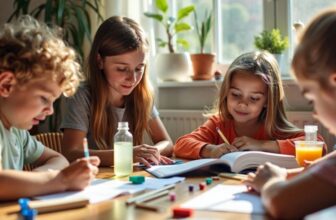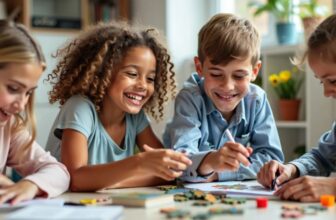
Play-based learning is an essential and delightful approach to education that combines fun with learning. It’s a philosophy that can be embraced not only in educational settings but also at home, providing children with a nurturing environment to foster creativity, curiosity, and a lifelong love of learning. By integrating play into everyday activities, children can explore the world around them and develop crucial cognitive, social, and physical skills. This article delves into creative educational activities that stimulate young minds and offers practical advice for cultivating a play-rich environment for young learners.
Key Takeaways
- Play-based learning fosters curiosity and creativity, engaging children’s senses and imagination through activities like treasure hunts and sensory gardens.
- Creating a stimulating play environment with open-ended toys and imaginative spaces at home encourages exploration and supports child-led learning.
- Integrating learning into everyday play can be achieved by asking open-ended questions and incorporating basic concepts into play activities, enhancing critical thinking and problem-solving skills.
- Physical development is nurtured through play, with activities focused on gross and fine motor skills, as well as yoga and mindfulness for young children.
- Outdoor play is invaluable, offering children the benefits of nature’s classroom where they can engage in exploration and document their discoveries, enriching their learning experience.
Encouraging Curiosity and Creativity in Young Learners

Fostering Inquisitiveness with Play-Based Learning
Play-based learning is a powerful approach to education that aligns with the natural curiosity of young children. By incorporating play into the learning process, we can create an environment that encourages children to explore and discover new concepts on their own terms. The benefits of play-based learning are manifold, ranging from the development of creativity and imagination to the enhancement of social and academic skills.
- Encourage exploration through activities like treasure hunts or sensory gardens.
- Engage children with creative endeavors such as painting, storytelling, or simple drama plays.
By asking open-ended questions and following the child’s lead, we can foster a love for learning that goes beyond the classroom.
It’s essential to provide a variety of open-ended toys and resources that stimulate the imagination and invite children to create their own narratives. Observing their interests and offering materials that align with their passions can significantly enhance their learning experience.
Creative Activities to Engage Young Minds
Engaging young minds through creative activities is essential for their cognitive and emotional development. Play is at the heart of what it means to be a kid, and by incorporating imaginative games and activities, children learn about the world around them in a fun and educational manner.
- Treasure hunts and sensory gardens allow children to explore their environment, fostering a deep love for learning.
- Arts and crafts activities, such as painting and clay modeling, promote fine motor skills and self-expression.
- Outdoor exploration, including nature walks and gardening, encourages physical health and an appreciation for the natural world.
By providing a variety of creative activities, we offer children the tools to express themselves and solve problems, laying the groundwork for a lifelong love of learning.
It’s important to stock up on resources that encourage exploration and creativity. Open-ended toys, art supplies, and books are invaluable in creating a stimulating environment. Following the child’s lead in play allows them to pursue their interests and passions, making learning a truly personalized experience.
The Role of Sensory Play in Encouraging Exploration
Sensory play is a critical component of early childhood development, often synonymous with messy play due to its hands-on nature. Sensory activities stimulate a child’s senses, leading to a wealth of developmental benefits.
Sensory bins filled with materials like rice or kinetic sand provide a tactile experience that can foster sensory development and creativity. Encouraging children to explore different textures and sensations helps to strengthen the nerve connections in their brains, which is essential for brain development.
By integrating sensory play into daily activities, parents and educators can create a stimulating environment that lays the foundation for meaningful learning experiences. It’s important to follow the child’s lead, providing materials that align with their curiosity and allowing them to drive the learning process.
Creating a Stimulating Play Environment at Home

Choosing Open-Ended Toys and Resources
Open-ended toys are a cornerstone of a stimulating play environment. Unlike toys with a predetermined use, open-ended toys like blocks, dress-up materials, and art supplies invite children to use their imagination and create their own narratives. These resources encourage exploration, creativity, and imagination, laying the foundation for meaningful learning experiences.
- Resources that promote cognitive learning, such as wooden animal puzzles, not only entertain but also engage young minds in problem-solving.
- Art supplies like paints, crayons, and clay foster artistic expression and fine motor skills development.
- Incorporating diverse toys that represent different races, cultures, and family structures can help children understand and appreciate diversity.
Embrace child-led play, where children choose the activities and drive the learning process. Observe their interests and passions, and provide materials and opportunities that align with their curiosity.
By carefully selecting open-ended toys and resources, parents and educators can create an environment that supports self-directed and guided play. This approach not only nurtures the child’s creativity but also contributes to their overall development.
Designing Spaces for Imaginative Play
Creating an inviting play space is essential for nurturing a child’s imagination and learning. Designate specific areas within your home that are dedicated to play. These areas should be safe, accessible, and equipped with materials that inspire creativity and exploration.
Choose vibrant colors and textures to stimulate the senses and create an energetic environment. Incorporate open-ended toys and resources that allow for a multitude of uses, fostering problem-solving and cognitive development.
Embrace child-led play by observing their interests and providing opportunities that align with their curiosity. This approach encourages children to take ownership of their learning and to engage deeply with the materials and spaces around them.
Remember to rotate toys and materials to maintain a fresh and engaging play area. This not only keeps the space interesting for children but also introduces new challenges and learning opportunities.
By thoughtfully designing play spaces at home, you can create a stimulating environment that supports play-based learning and the development of important social and cognitive skills.
Following the Child’s Lead in Learning
Embracing child-led play is essential for fostering a love of learning in young minds. By observing their interests and passions, we can provide materials and opportunities that align with their curiosity. This approach not only supports their current interests but also encourages the development of key competencies.
- Encourage your child to explore their own ideas and make choices about their play.
- Offer a variety of resources, such as open-ended toys and art supplies, to facilitate creative expression.
- Be present and attentive, showing enthusiasm for their discoveries and creations.
By following the child’s lead, we create a learning environment that is both nurturing and empowering. It allows children to feel valued and understood, which is vital to their emotional and academic development.
Focusing on your child’s strengths during play can significantly contribute to their confidence and progress. It’s important to celebrate their achievements, no matter how small, and to provide positive reinforcement that motivates them to continue exploring and learning.
Integrating Learning into Everyday Play

The Art of Asking Open-Ended Questions
Mastering the art of asking open-ended questions is a powerful tool in the educational journey of young minds. Engage children in conversations that spark curiosity and critical thinking by posing questions that cannot be answered with a simple ‘yes’ or ‘no’. Instead, encourage children to analyze, evaluate, and create by asking questions that require more thought and elaboration.
- How did you come up with that idea?
- What do you think would happen if…?
- Why do you think that is?
These types of questions are discussion gold, as they open the door to deeper understanding and learning. They also show children that their thoughts and opinions are valued, which can boost their confidence and willingness to participate.
By consistently incorporating open-ended questions into play, parents and educators can transform simple activities into rich, educational experiences.
Remember to allow plenty of time for children to think and respond. The goal is not to rush for answers but to enjoy the journey of exploration and discovery together.
Incorporating Basic Concepts into Play Activities
Integrating basic concepts into play is a seamless way to enhance a child’s learning experience. Counting steps during a game of hopscotch or identifying colors while painting can turn simple activities into educational opportunities.
- Engage children in sensory play with materials like rice or kinetic sand to explore textures and shapes.
- Use imaginative play spaces, such as a pretend kitchen, to teach concepts like numbers, sizes, and sequences.
- Encourage role-playing in scenarios like a doctor’s office to introduce new vocabulary and social interactions.
By weaving learning into the fabric of play, children absorb knowledge naturally and with joy. Reflecting on these activities helps solidify the concepts learned and encourages a deeper understanding.
Remember to follow the child’s interests and pace, making learning an adventure that they are eager to embark on every day.
The Importance of Documentation and Reflection
Proper documentation of a child’s learning journey is not just a formality; it’s a crucial tool for ensuring that educational experiences are tailored to meet their evolving needs. By keeping detailed records, educators and parents can track progress, identify areas for improvement, and celebrate milestones. This ongoing process of observation and reflection is essential for adapting teaching strategies and fostering a positive learning environment.
- Encourage children to document their play through drawings, journals, or photographs.
- Reflect on these documents to promote metacognition and help children make connections.
- Use anecdotal records to capture the ‘what, when, and where’ of learning moments.
Documentation is a bridge between teaching and learning. It allows for an in-depth understanding of a child’s experiences and paves the way for meaningful engagement with their educational path.
Formative assessment techniques such as portfolios and checklists are not just assessment tools; they are reflections of a child’s journey. They allow for a holistic view of development, capturing everything from language progression to social interactions. This insight is invaluable for adjusting teaching practices and preparing for the next steps in a child’s education.
Nurturing Physical Development Through Play

Gross Motor Skills: Encouraging Active Play
Active play is crucial for the development of gross motor skills in young children, providing them with the physical challenges that promote strength, balance, and coordination. Incorporating active play into daily routines can be both fun and beneficial for school readiness.
- Encourage activities that involve jumping, running, and climbing to build endurance and muscle power.
- Many preschool gross motor activities can be adapted to include rhythmical counting, which can help your child internalize number sequences.
- Outdoor play, such as navigating obstacle courses or playing ball games, enhances spatial awareness and motor planning.
By engaging in active play, children not only refine their gross motor skills but also gain confidence in their physical abilities, setting a strong foundation for future learning and development.
Remember, the key to fostering these skills is to provide opportunities for varied movement and to encourage practice through play. Like playdough and arts and crafts, active play encourages creativity while developing essential motor skills.
Fine Motor Skills: Activities for Babies and Toddlers
Developing fine motor skills is crucial for babies and toddlers as it lays the foundation for a range of daily activities and future academic tasks. Engaging infants in simple, playful exercises can significantly enhance their dexterity and hand-eye coordination. Here are a few activities that can be both fun and beneficial:
- Turning pages in books to promote finger strength and control.
- Playing with pom-poms and a whisk to encourage grasping and releasing.
- Waving ‘hi’ and ‘bye’ to develop wrist and finger movements.
- Engaging in edible, non-toxic finger painting for sensory and motor development.
Encourage your child to explore a variety of textures and movements through play. This not only supports their physical growth but also nurtures their curiosity and willingness to learn.
Remember, the key is to provide opportunities for your child to practice these skills in a relaxed and enjoyable environment. By incorporating these activities into your daily routine, you can give your child a head start in life.
Yoga and Mindfulness for Young Children
Introducing young children to the practices of yoga and mindfulness can have profound benefits on their physical and emotional development. Yoga enhances flexibility, strength, and coordination, while mindfulness encourages a state of active, open attention on the present. When children learn to pay attention to their breathing and how their bodies move, they develop a better sense of body awareness and self-regulation.
- Start with simple yoga poses that are fun and engaging for children.
- Incorporate games and stories to make the practice more relatable.
- Use mindfulness activities to help children learn to calm their minds and focus their attention.
Encouraging children to engage in yoga and mindfulness can help lay the foundation for a healthy and balanced lifestyle. It’s not just about the physical poses; it’s about nurturing a sense of peace and well-being that they can carry with them throughout their lives.
By making yoga and mindfulness a regular part of a child’s routine, parents and educators can provide tools for stress management and emotional resilience. This early introduction to self-care practices can support children in developing habits that promote mental health and concentration, both essential for learning and personal growth.
Embracing the Great Outdoors: Learning in Nature’s Classroom

The Benefits of Outdoor Play and Exploration
Outdoor play is not just a way to burn energy; it’s a vital component of a child’s development. Beyond mere recreation, outdoor play serves as a cornerstone for a child’s holistic development, fostering physical prowess, igniting creativity, and nurturing social skills. Children benefit greatly from gusts of fresh air, looking into the sky and past the horizon, learning to self-regulate when a bit uncomfortable, and embracing the unpredictability of nature.
- Exposure to natural elements
- Opportunities for unstructured play
- Development of risk assessment skills
Embracing the great outdoors allows children to connect with their environment, promoting a sense of wonder and respect for nature. It’s essential for young learners to experience the textures, sounds, and smells of the outdoors, as these sensory experiences are crucial for their cognitive and emotional growth.
Incorporating outdoor play into daily routines can be simple. Start with short walks, encourage play in different weather conditions, and provide tools for interaction with nature, like magnifying glasses or shovels. Remember, the goal is to foster a love for the outdoors and learning through exploration.
Setting the Stage for Nature-Inspired Learning
To cultivate a love for nature and inspire learning, it’s essential to create an environment that encourages children to explore and interact with the natural world. Start by dedicating a space outside where children can feel free to dig, plant, and observe wildlife. This could be a small garden area or a sandbox that mimics a natural habitat.
Outdoor and nature-based learning activities are not just about observation but also about interaction. Consider these steps to enhance the experience:
- Provide tools for digging, collecting, and examining nature’s treasures.
- Encourage art and creativity with natural materials like leaves, sticks, and stones.
- Set up a water play area to explore the properties of water and its inhabitants.
By integrating these elements into your outdoor space, you create an immersive learning environment that is both educational and enjoyable for children.
Remember, the goal is to make nature an accessible and regular part of children’s play, fostering a deep connection with the environment from a young age.
Documenting the Wonders of Outdoor Play
Outdoor play is not only a source of joy but also a rich educational experience. Encouraging children to document their outdoor adventures can deepen their engagement and understanding of the natural world. Here are a few ways to capture these moments:
- MAKE A RECORD of the various creatures and plants encountered during outdoor play. This can be done through drawings, photographs, or even creating a nature scrapbook.
- Encourage children to express their feelings and thoughts about their outdoor experiences in a journal. This helps in nurturing their language and communication skills.
- Use technology responsibly by allowing children to take pictures or videos, which can later be used for storytelling or sharing with peers and family.
Reflection on these documented experiences is crucial. It allows children to revisit their adventures and solidify the knowledge they’ve gained. This process of reflection can transform a simple play activity into a lasting learning experience.
By documenting the wonders of outdoor play, children not only preserve memories but also develop an appreciation for the environment and their place within it.
Conclusion
In the journey of childhood development, play-based learning stands as a cornerstone, nurturing the seeds of curiosity and creativity in young minds. From sensory gardens to imaginative role-playing, we’ve explored a plethora of activities that not only entertain but educate. These experiences are pivotal in shaping children’s cognitive, social, and emotional growth, providing a foundation for lifelong learning. As parents, educators, and caregivers, our role is to create environments rich in opportunities for exploration and discovery, where learning and play are seamlessly intertwined. By doing so, we empower our children to become inquisitive learners and imaginative thinkers, ready to embrace the world with open arms and bright minds.
Frequently Asked Questions
What is play-based learning and how does it benefit children?
Play-based learning is an educational approach that uses play as the primary method for teaching and learning. It allows children to explore, discover, and engage in activities that are both meaningful and enjoyable. This method fosters curiosity, creativity, and critical thinking, and helps children develop social, emotional, and cognitive skills in a natural and enjoyable way.
How can I create a stimulating play environment at home?
To create a stimulating play environment at home, provide a variety of open-ended toys, art supplies, books, and sensory materials that encourage exploration and creativity. Designate specific play areas and ensure they are safe and welcoming. Follow your child’s lead, observing their interests and offering resources that align with their passions.
What are some examples of play-based learning activities for home?
Examples of play-based learning activities for home include setting up sensory bins with materials like rice or kinetic sand, creating imaginative play spaces such as a pretend kitchen or doctor’s office, and engaging in role-playing to develop social skills and understanding of the world.
How can I integrate learning into everyday play?
Integrate learning into everyday play by asking open-ended questions that encourage children to think and problem-solve. Incorporate basic concepts such as counting, sorting, and identifying shapes into daily activities. Document and reflect on the play experiences to recognize learning milestones and interests.
Why is physical development important in play, and how can it be nurtured?
Physical development is crucial for a child’s overall growth and health. It can be nurtured through play by encouraging activities that develop gross motor skills, such as running and jumping, and fine motor skills, such as drawing or manipulating small objects. Yoga and mindfulness can also promote physical well-being and self-regulation in young children.
What are the benefits of outdoor play for children?
Outdoor play offers numerous benefits, including the development of physical skills, an appreciation for nature, improved attention spans, and opportunities for social interaction. It also encourages children to take risks, solve problems, and become more resilient. Nature’s classroom provides a dynamic, ever-changing environment for discovery and learning.






